再生与不讲义可再生能源(英文)
- 格式:ppt
- 大小:2.48 MB
- 文档页数:57

Renewable energy is a topic of great importance in todays world.It encompasses various sources of energy that can be replenished naturally and sustainably over time. Here are some key points to consider when discussing renewable energy in an English composition:1.Definition of Renewable Energy:Renewable energy is derived from natural resources that are constantly replenished,such as sunlight,wind,rain,tides,waves,and geothermal heat.2.Types of Renewable Energy:Solar Energy:Harnessed by solar panels that convert sunlight into electricity.Wind Energy:Generated by wind turbines that convert the kinetic energy of wind into electrical power.Hydropower:Produced by the movement of water in rivers or through tidal forces. Biomass Energy:Derived from organic materials such as wood,crops,and waste, which are burned to produce heat or electricity.Geothermal Energy:Extracted from the Earths internal heat,often used for heating and electricity production.3.Advantages of Renewable Energy:Environmental Benefits:Reduces greenhouse gas emissions and dependence on fossil fuels.Sustainability:Unlike finite resources,renewable energy sources are virtually inexhaustible.Economic Benefits:Can create jobs and stimulate economic growth in the energy sector.Energy Security:Diversifies energy sources,reducing reliance on imported fuels.4.Challenges of Renewable Energy:Intermittency:Renewable sources like solar and wind are not always available, requiring energy storage solutions.Infrastructure:Requires significant investment in new technologies and grid systems. Cost:Although costs are decreasing,initial investment in renewable energy projects can be high.Land Use:Largescale renewable energy projects may require significant land or water areas.5.Technological Advancements:Improvements in solar panel efficiency and wind turbine design.Development of energy storage technologies,such as batteries and pumped hydrostorage.Innovations in smart grid technology to better integrate renewable energy sources.ernment Policies and Incentives:Subsidies and tax incentives to encourage investment in renewable energy. Renewable energy targets and mandates to increase the share of renewable energy in the energy mix.Research and development funding to support technological advancements.7.Future Prospects:The potential for renewable energy to meet a growing portion of global energy demand. The role of renewable energy in combating climate change and achieving sustainable development goals.8.Conclusion:The importance of transitioning to a renewable energybased economy for a cleaner, more sustainable future.The need for continued research,investment,and policy support to overcome current challenges.When writing an essay on renewable energy,its essential to provide a balanced view, highlighting both the benefits and the challenges.Additionally,incorporating examples of how different countries or regions are adopting renewable energy can make the essay more engaging and informative.。

可再生能源英语作文Title: The Promising Future of Renewable Energy。
Introduction:In recent years, the world has witnessed a growing interest and investment in renewable energy sources. This shift towards renewable energy is driven by the need to address climate change, reduce dependency on fossil fuels, and ensure sustainable development. In this essay, we will explore the significance of renewable energy and its promising future.Importance of Renewable Energy:Renewable energy sources, such as solar, wind, hydro, and geothermal power, offer several advantages over traditional fossil fuels. Firstly, they are abundant and inexhaustible, unlike finite fossil fuel reserves. This ensures long-term energy security and stability. Secondly,renewable energy technologies produce minimal greenhouse gas emissions, thereby mitigating climate change and reducing air pollution. Thirdly, investing in renewable energy fosters economic growth by creating jobs,stimulating innovation, and attracting investment.Solar Energy:Solar energy is one of the most abundant and widely available sources of renewable energy. Photovoltaic (PV) panels convert sunlight into electricity, while solar thermal systems harness solar energy to generate heat. The declining cost of solar panels and advancements in technology have made solar energy increasingly competitive with conventional energy sources. Moreover, solar energy can be deployed at various scales, from rooftopinstallations to large utility-scale solar farms, making it versatile and accessible.Wind Energy:Wind energy is another promising renewable energysource with significant potential for expansion. Wind turbines convert the kinetic energy of wind into electricity, which can power homes, businesses, and even entire communities. Wind power has experienced rapid growth in recent years, driven by improvements in turbine efficiency, economies of scale, and favorable government policies. Offshore wind farms, situated in coastal areas, offer particularly high wind speeds and can contribute substantially to the energy mix.Hydropower:Hydropower, generated from flowing or falling water, has long been utilized as a renewable energy source. Hydroelectric dams harness the energy of rivers and streams to produce electricity. While large-scale hydropower projects have faced criticism for their environmental impact, such as habitat disruption and displacement of communities, small-scale hydroelectric systems and run-of-river installations offer more environmentally friendly alternatives. Additionally, pumped-storage hydropower facilities provide grid stability by storing excess energyand releasing it during periods of high demand.Geothermal Energy:Geothermal energy taps into the heat stored beneath the Earth's surface to generate electricity and heat buildings. Geothermal power plants utilize steam or hot water reservoirs to drive turbines and produce electricity. This reliable and constant source of energy is particularlywell-suited for regions with active geothermal activity, such as geysers, hot springs, and volcanic areas. With advancements in drilling techniques and geothermal technology, the potential for geothermal energy expansionis significant.Challenges and Opportunities:While renewable energy holds great promise, several challenges must be addressed to realize its full potential. These include intermittency, grid integration, energy storage, and initial capital costs. However, continued research, innovation, and supportive policies can overcomethese challenges and accelerate the transition to a renewable energy future. Additionally, decentralized energy systems, smart grids, and energy efficiency measures can enhance the reliability and resilience of renewable energy infrastructure.Conclusion:In conclusion, renewable energy represents a sustainable and environmentally friendly solution to the world's growing energy needs. By harnessing the power of the sun, wind, water, and Earth's heat, we can reduce our reliance on fossil fuels, mitigate climate change, and foster a cleaner and more prosperous future. Through collaborative efforts between governments, industries, and communities, we can unlock the full potential of renewable energy and create a more sustainable world for generations to come.。
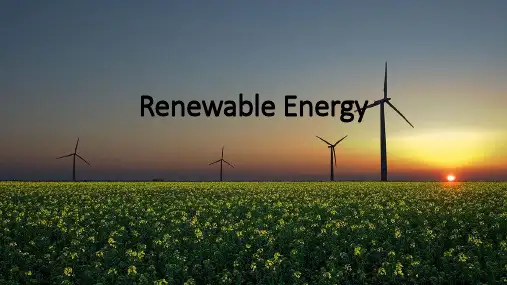
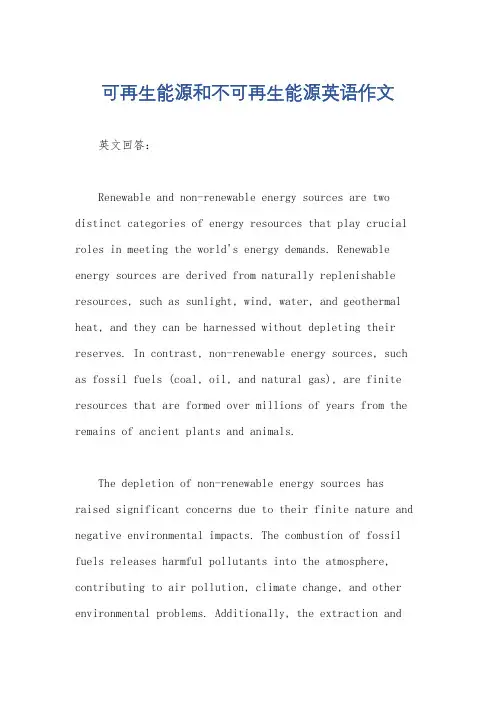
可再生能源和不可再生能源英语作文英文回答:Renewable and non-renewable energy sources are two distinct categories of energy resources that play crucial roles in meeting the world's energy demands. Renewable energy sources are derived from naturally replenishable resources, such as sunlight, wind, water, and geothermal heat, and they can be harnessed without depleting their reserves. In contrast, non-renewable energy sources, such as fossil fuels (coal, oil, and natural gas), are finite resources that are formed over millions of years from the remains of ancient plants and animals.The depletion of non-renewable energy sources has raised significant concerns due to their finite nature and negative environmental impacts. The combustion of fossil fuels releases harmful pollutants into the atmosphere, contributing to air pollution, climate change, and other environmental problems. Additionally, the extraction andproduction of fossil fuels can lead to land degradation, water pollution, and other environmental damage.In contrast, renewable energy sources offer numerous benefits that make them increasingly attractive as sustainable alternatives. These sources are environmentally friendly, producing minimal or zero emissions, thus mitigating air pollution and climate change. Renewable energy is also domestically available in many regions, reducing dependence on foreign energy imports and fostering energy independence. Furthermore, renewable energy technologies are becoming increasingly cost-competitive with traditional fossil fuels, making them economically viable options.Despite the advantages of renewable energy, there are challenges associated with their integration into existing energy systems. Intermittency, the variability in the availability of some renewable sources such as solar and wind, poses challenges to grid stability and requires careful planning and integration with other energy sources. Additionally, the cost of renewable energy technologies canbe higher than that of fossil fuels, although costs have been declining in recent years.To overcome these challenges and accelerate thetransition towards a sustainable energy future, governments, industries, and researchers are actively pursuing advancements in renewable energy technologies and policies. These efforts include investment in research and development, incentives for renewable energy adoption, and the establishment of supportive regulatory frameworks.In conclusion, renewable and non-renewable energy sources represent contrasting approaches to meeting the world's energy needs. While non-renewable energy sources have historically dominated the energy landscape, concerns over their depletion and environmental impacts have prompted a shift towards renewable energy sources. The benefits of renewable energy, including environmental friendliness, reduced emissions, energy independence, and cost-competitiveness, make them increasingly attractive as sustainable alternatives. However, challenges associatedwith intermittency and cost need to be addressed throughtechnological advancements and supportive policies to fully realize the potential of renewable energy in shaping a sustainable energy future.中文回答:可再生能源和不可再生能源。

可再生能源的英语作文Renewable energy is the future. It's clean, it's sustainable, and it's the key to reducing our reliance on fossil fuels. Solar power, for example, is a great sourceof renewable energy. It harnesses the power of the sun to generate electricity, and it's becoming more and more affordable as technology advances.Wind energy is another important source of renewable energy. Wind turbines can be found all over the world, and they're a great way to generate electricity without producing harmful emissions. Plus, they can be built in areas that are not suitable for other types of power plants, like in the middle of the ocean.Hydropower is also a major player in the world of renewable energy. It uses the energy of flowing or falling water to generate electricity, and it's one of the oldest and most widely used renewable energy sources in the world. It's also very reliable, as long as there's a consistentsource of water, like a river or a waterfall.Biomass energy is another important form of renewable energy. It's produced from organic materials, like wood, agricultural crops, and waste, and it can be used to produce heat, electricity, or even transportation fuels. Plus, it's a great way to reduce waste and lower greenhouse gas emissions.Geothermal energy is a lesser-known form of renewable energy, but it's incredibly powerful. It harnesses the heat from the earth's core to produce electricity and heat, and it's a very reliable and consistent source of energy. Plus, it's available 24/7, unlike solar or wind power, which are dependent on the weather.In conclusion, renewable energy is the way forward.It's clean, it's sustainable, and it's the key to reducing our reliance on fossil fuels. With advancements in technology and a growing awareness of the importance of sustainability, renewable energy is becoming more and moreaccessible, and it's only a matter of time before it becomes the dominant source of energy worldwide.。
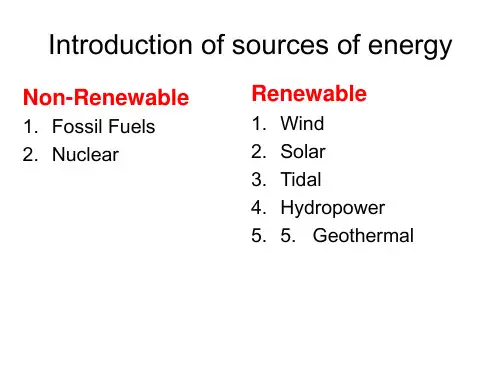
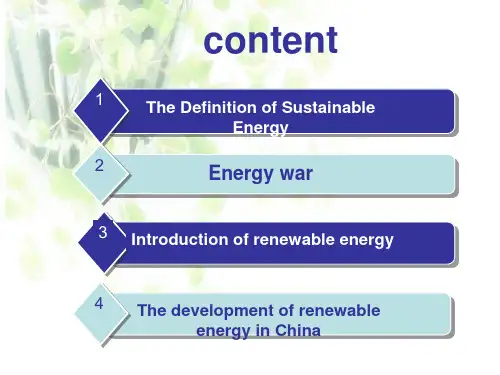
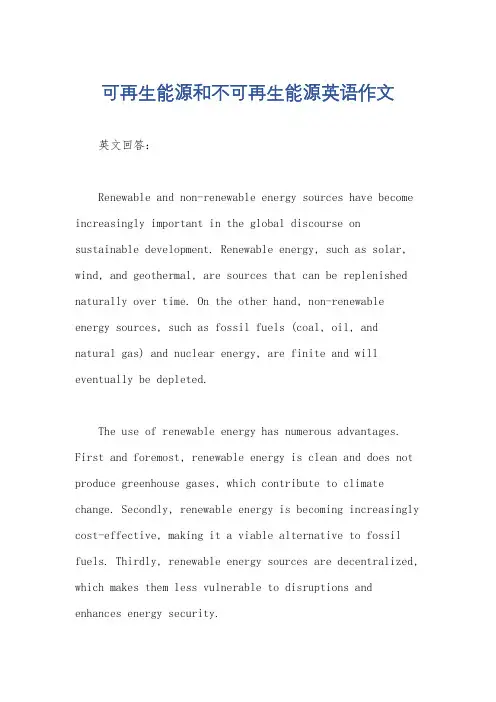
可再生能源和不可再生能源英语作文英文回答:Renewable and non-renewable energy sources have become increasingly important in the global discourse on sustainable development. Renewable energy, such as solar, wind, and geothermal, are sources that can be replenished naturally over time. On the other hand, non-renewable energy sources, such as fossil fuels (coal, oil, and natural gas) and nuclear energy, are finite and will eventually be depleted.The use of renewable energy has numerous advantages. First and foremost, renewable energy is clean and does not produce greenhouse gases, which contribute to climate change. Secondly, renewable energy is becoming increasingly cost-effective, making it a viable alternative to fossil fuels. Thirdly, renewable energy sources are decentralized, which makes them less vulnerable to disruptions and enhances energy security.However, renewable energy also has some limitations. One major challenge is intermittency. Solar and wind energy are not always available, and they can fluctuate significantly depending on weather conditions. This intermittency makes it difficult to rely solely on renewable energy sources to meet baseload demand. Secondly, the development of renewable energy projects often requires large upfront investments, which can be a barrier to entry for some communities.Non-renewable energy sources, on the other hand, are reliable and have high energy density. They have been the backbone of the global energy system for decades. However, the use of non-renewable energy sources comes with significant environmental and health risks. The combustion of fossil fuels releases harmful pollutants into the air, contributing to air pollution and respiratory illnesses. Additionally, the extraction and transportation of fossil fuels can have devastating impacts on ecosystems and biodiversity.Moreover, non-renewable energy sources are finite and will eventually run out. The world's reserves of fossil fuels are rapidly depleting, and it is estimated that we have only a few decades of oil and gas left. This scarcity creates a sense of urgency to transition to renewable energy sources.In conclusion, both renewable and non-renewable energy sources have their own advantages and disadvantages. Renewable energy is clean, sustainable, and becoming increasingly cost-effective. However, it is intermittent and requires large upfront investments. Non-renewable energy sources are reliable and have high energy density, but they are polluting, finite, and contribute to climate change. As the world faces the challenges of climate change and energy security, it is imperative to transition to a more sustainable energy system that relies primarily on renewable energy sources.中文回答:可再生能源和不可再生能源。

可再生能源英语单词The Rise of Renewable Energy: A Global Perspective.Renewable energy sources have become a pivotal aspectof the global energy mix, as the world strives to move towards a more sustainable and environmentally friendly future. These resources, derived from naturallyreplenishing sources such as sunlight, wind, water, and geothermal heat, offer a promising alternative to fossil fuels, which are not only finite but also contribute significantly to climate change.The need for renewable energy is urgent. The burning of fossil fuels releases vast amounts of carbon dioxide into the atmosphere, trapping heat and leading to global warming. This, in turn, is causing a range of environmental problems, including melting ice caps, extreme weather events, and changes in biodiversity. Renewable energy sources, by contrast, emit little or no greenhouse gases, making them a crucial part of the solution to climate change.Solar power is one of the most promising renewable energy sources. The sun provides an almost inexhaustible supply of energy, and solar panels have become increasingly efficient and cost-effective in recent years. From rooftops to deserts, solar panels are now a common sight, converting sunlight into electricity that powers homes, businesses,and even entire cities.Wind power is another rapidly growing renewable energy sector. Wind turbines harness the power of the wind to generate electricity, offering a clean and renewable source of energy that is particularly suitable for areas with strong wind resources. As technology improves, windturbines are becoming taller and more powerful, able to capture more energy from the wind and reduce their reliance on fossil fuels.Hydroelectric power, which uses the force of moving water to generate electricity, is another well-established renewable energy source. Large-scale hydroelectric projects, such as dams and reservoirs, have been in use for centuries,but recent developments in small-scale hydroelectricity, such as micro-hydro and pico-hydro systems, are making this technology more accessible and versatile.Geothermal energy, which harnesses the heat from the Earth's interior, is another renewable energy source with巨大的潜力. This type of energy can be used for both electricity generation and heating purposes, and it is particularly suitable for areas with geologically active features such as volcanoes and hot springs.The transition to renewable energy sources is not without its challenges. Investment in renewable energy infrastructure requires significant capital, and the technology and expertise to harness these resources effectively are still being developed. Furthermore, the intermittency of some renewable energy sources, such as solar and wind, can pose challenges for energy grids that are designed to operate with a steady supply of power.Despite these challenges, the benefits of renewable energy are clear. Not only do these sources of energy helpto mitigate climate change and protect the environment, but they also create jobs and economic opportunities in the clean energy sector. As the world continues to grapple with the urgent need to transition to more sustainable energy sources, renewable energy will play a crucial role in shaping our future.In conclusion, renewable energy sources offer a promising and necessary alternative to fossil fuels. As the world faces the dual challenges of climate change and energy security, investing in renewable energy is not only a smart economic decision but also a moral imperative. By harnessing the power of the sun, wind, water, and Earth's interior, we can build a cleaner, safer, and more sustainable future for ourselves and the next generation.。
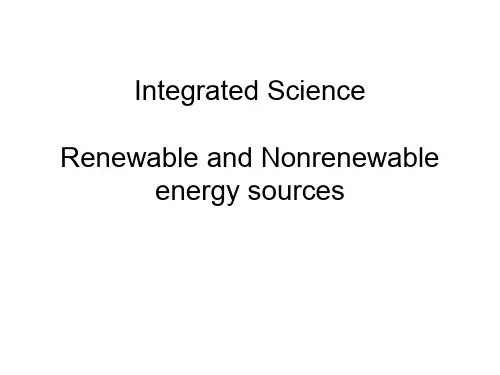

可再生能源英语作文Renewable energy is the future. It's clean, sustainable, and abundant. We need to shift our focus from fossil fuelsto renewable sources like solar, wind, and hydro power. These energy sources have numerous benefits. For one, they don't produce harmful emissions that contribute to climate change. This means cleaner air and a healthier planet for future generations. Additionally, renewable energy is infinite. We will never run out of sunlight, wind, or water. This is in stark contrast to fossil fuels, which are finite and will eventually be depleted.Solar power is one of the most widely used forms of renewable energy. It harnesses the energy from the sun and converts it into electricity. Solar panels are becoming increasingly affordable and efficient, making it a viable option for many homeowners and businesses. Not only does solar power reduce our reliance on fossil fuels, but italso helps to lower electricity bills. It's a win-win situation for both the environment and our wallets.Wind power is another important source of renewable energy. Wind turbines capture the energy from the wind and convert it into electricity. They can be found in both onshore and offshore locations, taking advantage of the natural wind patterns. Wind power is a clean and sustainable source of energy, and it has the potential to provide a significant portion of our electricity needs. In fact, some countries have already achieved impressivelevels of wind energy generation.Hydro power, or hydropower, is generated from the movement of water. It can be harnessed from rivers, waterfalls, and even ocean tides. Hydroelectric power plants use turbines to convert the energy from flowing water into electricity. This form of renewable energy is reliable and consistent, as water flow can be controlled.It also has the advantage of being able to store energy, which can be used during times of high demand. However, the construction of hydroelectric dams can have negative impacts on the environment and local ecosystems, so careful planning and consideration are necessary.In conclusion, renewable energy is the way forward. It offers a sustainable and clean alternative to fossil fuels. Solar power, wind power, and hydro power are just a few examples of the diverse range of renewable energy sources available to us. By investing in and promoting these sources, we can reduce our carbon footprint and create a brighter future for our planet. It's time to embrace renewable energy and make a positive change for generations to come.。
可再生能源英语作文Renewable energy, also known as clean energy, isderived from natural processes that are replenished constantly. This includes sunlight, wind, rain, tides, waves, and geothermal heat. Unlike fossil fuels, renewable energy sources are not depleted and do not harm the environment.Solar energy is one of the most abundant and readily available sources of renewable energy. It is captured through the use of solar panels, which convert sunlightinto electricity. This clean and sustainable energy sourceis becoming increasingly popular as technology advances and costs decrease.Wind power is another important renewable energy source. Wind turbines convert the kinetic energy of the wind into mechanical power, which can then be used for electricity generation. Wind energy is clean, abundant, and does not produce greenhouse gas emissions during operation.Hydropower, or hydroelectric power, is generated from the energy of moving water. It is one of the oldest sources of renewable energy and provides a significant portion of the world's electricity. However, the construction of dams and reservoirs for hydropower can have negative environmental impacts on river ecosystems.Geothermal energy is derived from the heat of theearth's core. It is a reliable and sustainable source of power that can be used for heating and electricity generation. Geothermal power plants emit low levels of greenhouse gases and can be built on land that is unsuitable for other uses.Bioenergy, derived from organic materials such as plants and animal waste, is another form of renewable energy. This includes biofuels, which can be used for transportation, and biomass, which can be burned to produce heat and electricity. However, the production and use of bioenergy can have complex environmental and social implications.In conclusion, renewable energy is a crucial part of the solution to climate change and environmental degradation. By harnessing the power of natural processes, we can reduce our reliance on fossil fuels and minimize our impact on the planet. It is important to continue developing and investing in renewable energy technologies to create a more sustainable and cleaner future.。
R e n e w a b l e E n e r g y R e s o u r c e s 可再生能源资源1.Introduction引言Some sources of energy are known as renewable energy resources.This is because,unlike non-renewable energy resources,they will not run out.一些能源被称为可再生能源资源。
这是因为,不像不可再生能源资源,他们不会用完。
Renewable energy resources include solar energy,geothermal energy,energy from the wind or waves,energy from tides and energy from biomass.可再生能源包括太阳能、地热能、风能或波浪能、潮汐能和来自生物的能量。
2.Solar energy太阳能Every year the earth receives about 3*1010 billion kilojoule of energy. This energy drives processed in the atmosphere that cause the wind and waves.每年地球接收大约3×1011亿千焦耳的能量。
这种能量驱动在大气中处理,导致风和波浪。
Some energy is absorbed by green plants and used to make food by photosynthesis.So ultimately,the sun is source of most energy resources available to us,including fossil fuels.一些能源被绿色植物吸收,并用来通过光合作用制造食物。